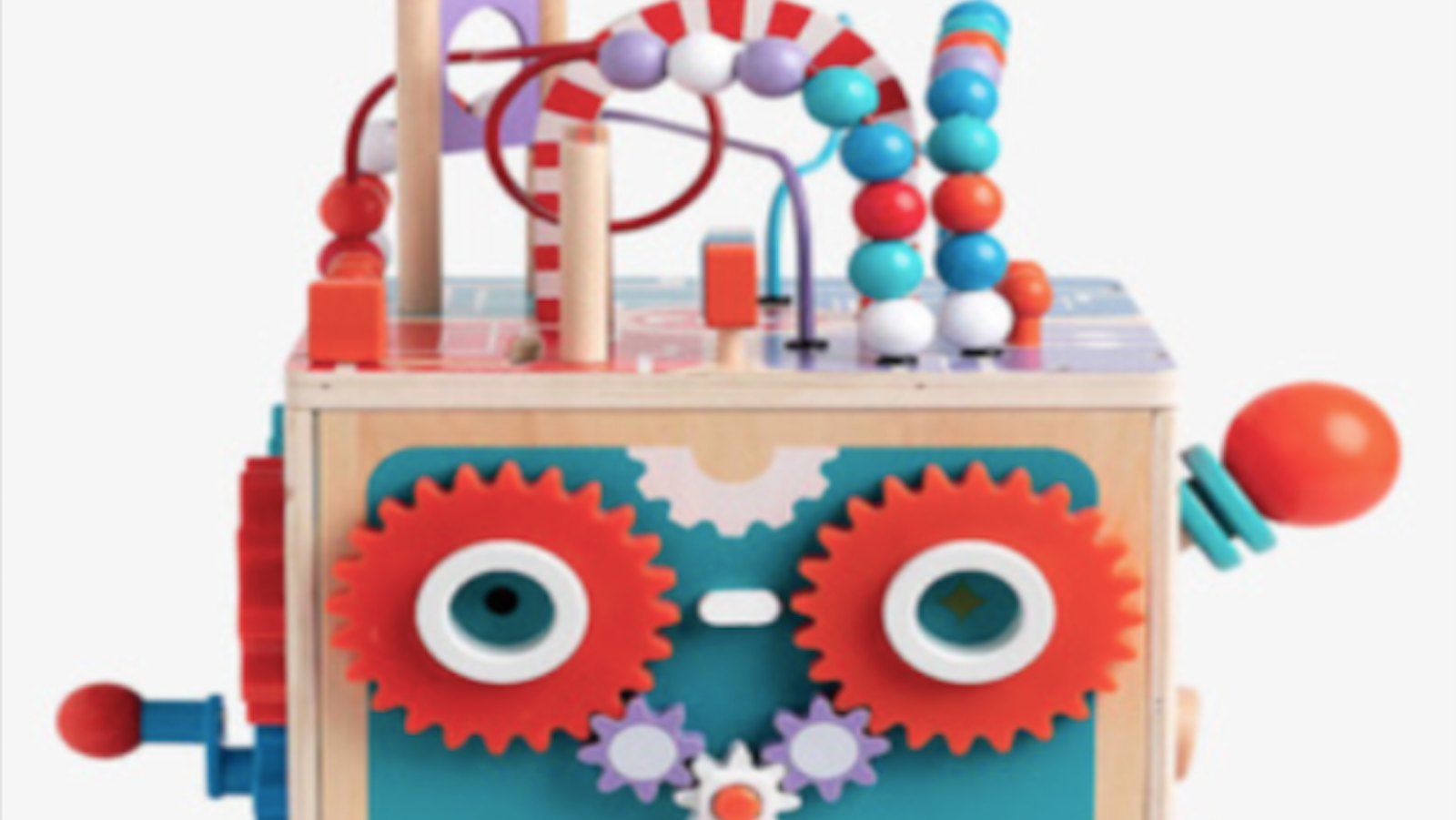
Toy safety tips for families and gift-givers
Here's a great list of safety tips for parents with children of all ages.

VIEW THE PDF
We expect toys to be fun, not dangerous. But sometimes there are safety issues.
Here are tips to make sure toys you buy — or that your children already have — are safe and stay safe after months or years of hard play. We also talk about the importance of adhering to warning labels. And we include tips on spotting counterfeit toys and techy products that can invade your children’s privacy.
PDF OF TOY SAFETY TIPS FOR PARENTS AND CAREGIVERS
FOR EVERYONE WITH ALL TOYS:
- Carefully check toys, both when they’re new and every so often to see whether there’s wear and tear. You’re particularly looking for any parts that are loose or could easily break off and be swallowed or cut the child.
- When your child gets a new toy, and periodically after that, check whether the toy has been recalled by going to cpsc.gov/recalls. Check for incidents as well as recalls at saferproducts.gov
- Evaluate whether particular toys are appropriate for your children, starting with the minimum age warning label. Even if your child is “old enough,” they may not be able to be trusted to play with the toy as intended. “Remember, the age-grading isn’t about how smart your child is—it’s safety guidance that’s based on the developmental skills and abilities of children at a given age, and the specific features of the toy,” said Joan Lawrence, senior vice president of standards and regulatory affairs for The Toy Association.
Also consider whether your child is also responsible enough to keep the toy out of reach of any younger children.
- Be leery of toys from unfamiliar sellers or international sellers. They may be more likely to sell counterfeit toys or toys that don’t meet U.S. safety standards.
- When researching a toy, check whether the manufacturer has its own, official website. “We always tell toy shoppers that if they are not familiar with an online seller, simply do a bit of research,” Lawrence said. Go to the website, and read reviews and online descriptions. “If there are a lot of typos and grammatical errors or poorly photoshopped images, it’s likely that the product is a counterfeit or imitation toy,” she said.
- Look for labeling on toys that says it’s non-toxic.
- Make sure that anything that’s electric says it’s UL-approved.
- Vintage toys are great for the memories, but be wary of toys made before 2008, when the Consumer Product Safety Improvement Act took effect. Toys that comply with that law are safer in many ways. The law set new limits on lead, phthalates and heavy metals, and requires third-party testing to make sure toys meet ASTM F963-17, which is the Standard Consumer Safety Specification for Toy Safety that covers a range of potential hazards in toys.
- For scooters, hoverboards and other riding toys, require your child to wear safety gear – particularly helmets that fit properly, said Dr. Jerri Rose, associate division chief of pediatric emergency medicine, UH-Rainbow Babies & Children’s Hospital in Cleveland.
- Also make sure they understand how to ride on streets shared by vehicles that can injure or kill them. Just because a child is a certain age doesn’t automatically mean they can be trusted. “Maybe they’re not ready to be responsible,” Rose said. “Parents need to make sure their child is able to handle those in a safe way.”
- Report incidents involving toys to the CPSC at saferproducts.gov
FOR YOUNGER CHILDREN:
- For any toys with plastic film coverings on toys to protect them during shipping, be sure to remove the film. It’s often found on mirrors or parts that can be scratched before use. It can pose a choking hazard to children.
- Keep small balls, blocks and other toys with small parts out of reach from children younger than 3.
- High-powered tiny magnets are now prohibited from being manufactured. But the new federal rule doesn’t affect magnets that may be in people’s homes. If you have children or teens in your home, you shouldn’t have tiny magnets, the American Academy of Pediatrics says. Also explain to your kids how dangerous these magnets are, in case they come across them at a friend’s house.
- Certain types of water beads haven’t yet been banned, but they’re dangerous for young children.
- Keep deflated balloons away from children younger than 8 and keep your ears open for an inflated balloon that pops. Children can choke on balloons that haven’t been blown up and ones that have broken.
- For children younger than 18 months, keep them away from toys with any strings, straps or cords longer than 12 inches.
- If there are batteries, especially button batteries, make sure the compartments are secure and can’t be opened by a young child. In addition, make sure to never leave new or used batteries where children can reach them.
- Watch out for painted jewelry, cheap metal or other toys with paint that seems to chip off easily. We know young children often put things in their mouths. The objects could contain lead, which is particularly harmful to children’s developing brains and nervous systems.
TIPS FOR TECHY TOYS:
- Research the toy’s potential safety risks before buying. Make sure there are no reports of a toy posing known dangers to children. Search the toy manufacturer online to see if there are any news reports or government actions against it for violating privacy standards, and avoid those with a spotty record. Looking up reviews of the toy may also help you identify toys that have made parents feel uncomfortable.
- Understand all of the toy’s features. Make sure you understand exactly what the toy can do. Consider what features will work best for your family.
Features to consider carefully:
Cameras, microphones or sensors
Chat functions
Location sharing
In-app purchases
Level of individual personalization the toy is programmed to accomplish
Features that can be helpful:
Parental safety controls
Ability to set time limits - Look for toys with a physical component to connect it to the internet: This can be as simple as having a button on the toy you must press in order to link it to other devices. Making sure someone must physically interact with the toy helps cut down on the risks of strangers abusing its internet connection. Some toys will require you to enter a password in an app to connect with the toy. This is a good feature to have, but physical requirements are best.
- Read the terms and conditions. Disclosures, and terms and conditions aren’t fun or easy to read, but when it comes to toys, it’s important for parents to read enough to try and find answers to key questions. These include:
If the toy has a microphone or a camera, is it recording your child’s interactions with it? Are those communications transferred anywhere? To whom, and for what purpose?
Is the toy collecting any other information about your child, or transferring it to any company that isn’t the manufacturer? Best to find manufacturers and toys that don’t share any data at all.
How long does the company keep your child’s data on file? The company should keep data only for as long as is required to fulfill its play function. If the policy doesn’t explicitly state how long the company keeps data, this can be a red flag.
Does the company state it is allowed to change terms and conditions without notifying you? This can be a red flag, too.
Unfortunately, it’s possible you won’t find the answers to all of these questions in the terms and conditions or privacy policies. These documents can be purposefully vague and omit important information. If this is the case, it’s safer to find a different toy made by a company that takes the security of children more seriously.
- Supervise playtime, especially with younger kids. Establish with your child that playtime with the toy is only with parental supervision. This helps to ensure that if someone hacks the toy and is using it to interact with your child, you can take action immediately.
- Turn it off. Always turn the toy off when not in use. For younger children, store it in a place your child can’t reach when playtime is over to ensure they can’t turn it on without supervision, re-enabling the toy to pose unmonitored risks.
- Stay on top of security updates. Many web-enabled toys and their companion apps will issue periodic updates. These are important to keep your family safe.
TIPS FOR PARENTS ON DRONES
Drones have become increasingly popular in recent years. However they come with their unique set of concerns. They come with special legal restrictions, like possible registration requirements with the Federal Aviation Administration.
To protect children when using drones, parents can consider these issues:
- Drone size: Choose the right size drone for your child. Larger heavier drones will have faster and heavier propellers and may be more difficult to control and a problem for younger children.
- Pets and wildlife: Teach your child to keep their drone a safe distance from all animals (domestic and wild). The noise and movement may make an animal anxious or agitated, risking harm to all involved.
- Registration: Depending on the drone you buy and if it is over a certain weight, it must be registered, and the user must adhere to specific guidelines. The Federal Aviation Administration (FAA) oversees drone rules but states and localities may place additional restrictions. The FAA requires all drones that weigh greater than 0.55 lbs (250 grams) to be registered.
- Age restrictions: Research whether there is a minimum age for drone pilots in your area. Ensure your child meets the legal age requirements or that they are supervised by an adult if necessary.
- Privacy: Parents should supervise and educate their kids on privacy considerations. Privacy breaches can lead to legal consequences, so it’s essential to fly drones responsibly and ethically.
- Boundaries: Make sure your kid understands where is and isn’t appropriate for flight. Avoid areas with heavy traffic, airports or private properties without permission.
TIPS FOR PARENTS ON ROBLOX
Roblox offers a creative and engaging online platform for kids to design games, interact with friends and unleash their creativity, but it’s not without its potential dangers.
Roblox hosts user-made content, which can sometimes be explicit or violent. It also allows other players to interact with one another; earlier this year an 11-year-old girl from Delaware was kidnapped from her home by an adult who communicated to her through Roblox. It also contains in-app purchases, and some experts have raised the alarm that it might be addictive for some kids.
To protect children, parents can:
- Use customized parental controls: Use features that restrict chat capabilities, set spending limits and enforce account restrictions. Make sure only approved friends can join your child’s games.
- Teach your child about in-app purchases: Children should learn about in-app purchases and the real costs associated with virtual items. Explain the importance of getting permission before making any purchases. Set spending limits inside the app.
- Educate children about privacy: If your child is going to play on Roblox with others, they should be told to limit interactions and not share details such as their real name, location or age. Parents may want to take an interest in their child’s gaming experience, particularly if their child is reporting any new friends or regular acquaintances in the game.
TIPS FOR PARENTS ON SMARTWATCHES
Smartwatches may provide entertainment for kids and peace of mind for parents hoping to have a way to communicate with their child before making the jump to buying a smartphone. There are some security and privacy considerations for parents and guardians. For example, testing of some brands has shown security vulnerabilities that could expose real-time location data. Others can include features like calorie counters that some have questioned as encouraging unhealthy behavior in children.
To protect children, parents can:
- Research up front: Look for flags that a smartwatch manufacturer has had trouble with safety and security previously. For example, Mozilla Foundation’s Privacy Not Included website reviews products including smartwatches that can be helpful. They’ve flagged the Huawei Watch Kids 4 Pro and the Verizon GizmoWatch as having less than ideal data practices.
- Evaluate features: Determine which features are essential for your child. Consider factors like GPS tracking, communication, games and apps, and decide how comfortable you are with each. Some smartwatches have features like calorie counters, which some have raised could shift kids’ focus from healthy play to obsessive tracking behaviors.
- Privacy controls: Prioritize smartwatches with robust privacy controls. Make sure the watch has settings to restrict location sharing and limit access to sensitive data.
- Parental monitoring: Choose a smartwatch that gives you the parental controls you’re hoping for, such as tools for checking your child’s location or time limits on games. Many smartwatches offer companion apps for parents to stay connected and informed.
- Data protection: Verify how a smartwatch handles and stores data by using Ctrl + F on Windows or Cmnd + F on IOS when reading a watch’s privacy policy. Search for the terms “data” or “security” to find how that company uses data. For further guidance on deciphering privacy policies, see PIRG’s guide.
TIPS FOR PARENTS ON SMART SPEAKERS
Smart speakers such as Amazon Echo, Google Nest and Apple HomePod have become common in American households, offering convenience and entertainment. However, they also raise some real concerns.
Smart speakers are known for their data collection capabilities, and different companies have different policies. In 2023, Amazon paid $25 million to settle FTC and DOJ allegations it had violated COPPA for failing to delete young users’ voice and geolocation data collected by its smart speakers.
Because smart speakers can access the internet, kids may request or encounter inappropriate content. In one case, academic researchers were able to smuggle 234 policy-violating skills onto the Alexa Skills Store, the marketplace for third-party apps on the Echo smart speaker. Kids have also accidentally spent a lot of money while talking to a smart speaker. One 6-year-old spent $160 by simply asking her Amazon Echo device: “Can you play dollhouse with me and get me a dollhouse?”
To protect children when using smart speakers, parents can:
- Enable parental controls: Most smart speaker platforms offer parental control features that allow parents to restrict access to explicit content and certain features.
- Review voice history: Periodically review voice command history and any recorded conversations to ensure your child’s privacy is protected and submit deletion requests.
- Put the smart speaker in a communal place: This makes it easier to monitor how your child interacts with the speaker.
- Disable voice purchasing: To avoid disable voice purchasing or require a PIN or password for purchases. This extra layer of security can prevent unexpected charges.
- Regularly update firmware: Keep the smart speaker’s firmware up to date. Manufacturers often release updates that can enhance security and privacy features to prevent the risk of cyber attack stealing your or your kids’ data.
Topics
Authors
Teresa Murray
Consumer Watchdog, U.S. PIRG Education Fund
Teresa directs the Consumer Watchdog office, which looks out for consumers’ health, safety and financial security. Previously, she worked as a journalist covering consumer issues and personal finance for two decades for Ohio’s largest daily newspaper. She received dozens of state and national journalism awards, including Best Columnist in Ohio, a National Headliner Award for coverage of the 2008-09 financial crisis, and a journalism public service award for exposing improper billing practices by Verizon that affected 15 million customers nationwide. Teresa and her husband live in Greater Cleveland and have two sons. She enjoys biking, house projects and music, and serves on her church missions team and stewardship board.
R.J. Cross
Director, Don't Sell My Data Campaign, U.S. PIRG Education Fund
R.J. focuses on data privacy issues and the commercialization of personal data in the digital age. Her work ranges from consumer harms like scams and data breaches, to manipulative targeted advertising, to keeping kids safe online. In her work at Frontier Group, she has authored research reports on government transparency, predatory auto lending and consumer debt. Her work has appeared in WIRED magazine, CBS Mornings and USA Today, among other outlets. When she’s not protecting the public interest, she is an avid reader, fiction writer and birder.
Find Out More

Food for Thought 2024

Safe At Home in 2024?

5 steps you can take to protect your privacy now

